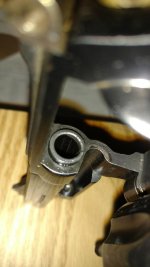I've seen so many opinions on this topic, but I haven't seen a poll around here about it.
So, How many of you have actually had one of their K frame 357's experience the infamous cracked forcing cone vs. how many have actually seen one in person vs. how many have only seen pictures of one on the internet?
I know I fall into the third group - all I've ever seen is photos of them.
Of course you can select multiple answers if you have both owned, seen, and seen photos of cracked forcing cones.
So how common is this problem really?
If you have had or even seen one, tell us all about it.
So, How many of you have actually had one of their K frame 357's experience the infamous cracked forcing cone vs. how many have actually seen one in person vs. how many have only seen pictures of one on the internet?
I know I fall into the third group - all I've ever seen is photos of them.
Of course you can select multiple answers if you have both owned, seen, and seen photos of cracked forcing cones.
So how common is this problem really?
If you have had or even seen one, tell us all about it.
Last edited:



